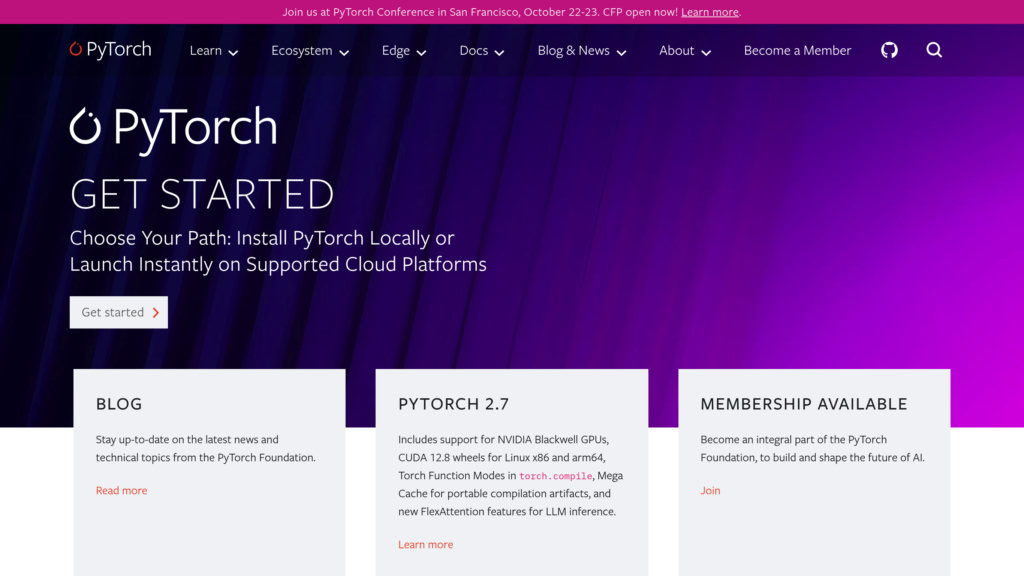PyTorch
Open-source deep learning framework providing dynamic tensor computation and flexible neural network building with strong GPU acceleration.
Community:
Product Overview
What is PyTorch?
PyTorch is a popular machine learning library developed by Meta AI, designed for applications like computer vision and natural language processing. It offers a dynamic computation graph, enabling flexible model experimentation and rapid prototyping. PyTorch combines tensor computation similar to NumPy with powerful GPU acceleration, alongside a tape-based automatic differentiation system for easy gradient calculation. Its rich ecosystem includes libraries for vision, text, and audio, supporting both research and production deployment.
Key Features
Dynamic Computation Graphs
Enables on-the-fly graph construction, allowing immediate model changes and facilitating fast experimentation.
Tensor Computation with GPU Acceleration
Provides multi-dimensional arrays (tensors) that operate efficiently on CPUs and GPUs for high-performance numerical computing.
Automatic Differentiation (Autograd)
Automatically computes gradients for all tensor operations, simplifying neural network training and backpropagation.
Robust Ecosystem
Includes specialized libraries like TorchVision, TorchText, and TorchAudio to accelerate development in vision, NLP, and audio domains.
Seamless Transition to Production
Supports TorchScript for model serialization and optimization, plus TorchServe for scalable deployment.
Distributed Training and Cloud Support
Offers scalable distributed training capabilities and compatibility with major cloud platforms for large-scale model training.
Use Cases
- Research and Experimentation : Preferred by researchers for prototyping novel deep learning models due to its flexible and dynamic architecture.
- Natural Language Processing : Used extensively for tasks like text generation, sentiment analysis, machine translation, and named entity recognition.
- Computer Vision : Applied in image classification, object detection, image generation, and medical imaging analysis.
- Speech Recognition and Synthesis : Enables development of voice assistants and speech processing models.
- Reinforcement Learning : Supports training of agents in complex environments for decision-making and control tasks.
- Generative Models : Facilitates creation of models like GANs and VAEs for image generation, style transfer, and data augmentation.
FAQs
PyTorch Alternatives
Weights & Biases
AI developer platform for training, tracking, and deploying machine learning models.
魔搭社区
China's largest open-source model community providing comprehensive access to over 1,000 models across vision, speech, NLP, and multimodal domains.
TensorFlow
Open source machine learning platform providing comprehensive tools for building, training, and deploying ML models across any environment.
Lightning AI
End-to-end AI platform for building, training, and deploying models with integrated tools and scalable infrastructure.
Sakana AI
Tokyo-based AI research company pioneering nature-inspired foundation models and fully automated AI-driven scientific discovery.
marimo
An open-source reactive Python notebook designed for reproducible, interactive, and shareable data workflows stored as pure Python files.
AfterQuery
Specialized AI data platform providing high-quality, expert-generated datasets to enhance AI model performance in complex professional domains.
Massed Compute
Flexible, on-demand GPU and CPU cloud compute provider offering enterprise-grade NVIDIA GPUs with transparent pricing and expert support.
Analytics of PyTorch Website
🇺🇸 US: 21.94%
🇨🇳 CN: 13.39%
🇭🇰 HK: 7.06%
🇮🇳 IN: 5.44%
🇰🇷 KR: 4.43%
Others: 47.74%
